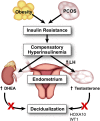Obesity and PCOS: the effect of metabolic derangements on endometrial receptivity at the time of implantation
- PMID: 25488942
- PMCID: PMC4275454
- DOI: 10.1177/1933719114561552
Obesity and PCOS: the effect of metabolic derangements on endometrial receptivity at the time of implantation
Abstract
Successful embryonic implantation is the result of a receptive endometrium, a functional embryo at the blastocyst stage and a synchronized dialog between maternal and embryonic tissues. Successful implantation requires the endometrium to undergo steroid-dependent change during each menstrual cycle, exhibiting a short period of embryonic receptivity known as the window of implantation. The term "endometrial receptivity" was introduced to define the state of the endometrium during the window of implantation. It refers to the ability of the endometrium to undergo changes that will allow the blastocyst to attach, penetrate, and induce localized changes in the endometrial stroma. These changes are metabolically demanding, and glucose metabolism has been proven to be important for the preparation of the endometrium for embryo implantation. Obesity and polycystic ovary syndrome (PCOS) represent 2 common metabolic disorders that are associated with subfertility. The aim of this review is to summarize the effect of obesity and PCOS on endometrial receptivity at the time of implantation. Focus will be on metabolic alterations that regulate decidualization, including glucose metabolism, hyperinsulinemia, and hyperandrogenism.
Keywords: PCOS; endometrial receptivity; implantation; metabolism; obesity.
© The Author(s) 2014.
Conflict of interest statement
Figures


Similar articles
-
Endometrium in PCOS: Implantation and predisposition to endocrine CA.Best Pract Res Clin Endocrinol Metab. 2006 Jun;20(2):235-44. doi: 10.1016/j.beem.2006.03.005. Best Pract Res Clin Endocrinol Metab. 2006. PMID: 16772154 Review.
-
Proinflammatory environment and role of TNF-α in endometrial function of obese women having polycystic ovarian syndrome.Int J Obes (Lond). 2016 Nov;40(11):1715-1722. doi: 10.1038/ijo.2016.154. Epub 2016 Aug 29. Int J Obes (Lond). 2016. PMID: 27569685
-
Basic aspects of endometrial receptivity in PCOS patients.Mol Biol Rep. 2022 Feb;49(2):1519-1528. doi: 10.1007/s11033-021-06976-9. Epub 2022 Jan 6. Mol Biol Rep. 2022. PMID: 34988892 Review.
-
Endometrium in women with polycystic ovary syndrome during the window of implantation.Rev Assoc Med Bras (1992). 2011 Nov-Dec;57(6):702-9. doi: 10.1590/s0104-42302011000600020. Rev Assoc Med Bras (1992). 2011. PMID: 22249553 Review. English, Portuguese.
-
Lipid metabolism and endometrial receptivity.Hum Reprod Update. 2022 Nov 2;28(6):858-889. doi: 10.1093/humupd/dmac026. Hum Reprod Update. 2022. PMID: 35639910 Review.
Cited by
-
The predictive value of preoperative luteinizing hormone to follicle stimulating hormone ratio for ovulation abnormalities recovery after laparoscopic sleeve gastrectomy: A prospective cohort study.Front Endocrinol (Lausanne). 2023 Jan 5;13:1043173. doi: 10.3389/fendo.2022.1043173. eCollection 2022. Front Endocrinol (Lausanne). 2023. PMID: 36686491 Free PMC article.
-
Pre-pregnancy body mass index and time to pregnancy among couples pregnant within a year: A China cohort study.PLoS One. 2020 Apr 23;15(4):e0231751. doi: 10.1371/journal.pone.0231751. eCollection 2020. PLoS One. 2020. PMID: 32324768 Free PMC article.
-
Mice endometrium receptivity in early pregnancy is impaired by maternal hyperinsulinemia.Mol Med Rep. 2017 May;15(5):2503-2510. doi: 10.3892/mmr.2017.6322. Epub 2017 Mar 14. Mol Med Rep. 2017. PMID: 28447735 Free PMC article.
-
A comparison of IVF outcomes transferring a single ideal blastocyst in women with polycystic ovary syndrome and normal ovulatory controls.Arch Gynecol Obstet. 2020 Dec;302(6):1479-1486. doi: 10.1007/s00404-020-05699-9. Epub 2020 Jul 15. Arch Gynecol Obstet. 2020. PMID: 32671545
-
Effects of Soy Isoflavones, Resistant Starch and Antibiotics on Polycystic Ovary Syndrome (PCOS)-Like Features in Letrozole-Treated Rats.Nutrients. 2021 Oct 24;13(11):3759. doi: 10.3390/nu13113759. Nutrients. 2021. PMID: 34836015 Free PMC article.
References
-
- Paulson RJ. Hormonal induction of endometrial receptivity. Fertil Steril. 2011;96 (3):530–535. - PubMed
-
- Rashid NA, Lalitkumar S, Lalitkumar PG, Gemzell-Danielsson K. Endometrial receptivity and human embryo implantation. Am J Reprod Immunol. 2011;66 (suppl 1):23–30. - PubMed
-
- Lessey BA. Assessment of endometrial receptivity. Fertil Steril. 2011;96 (3):522–529. - PubMed
-
- Berlanga O, Bradshaw HB, Vilella-Mitjana F, Garrido-Gómez T, Simón C. How endometrial secretomics can help in predicting implantation. Placenta. 2011;32 (suppl 3):S271–S275. - PubMed
Publication types
MeSH terms
Substances
Grants and funding
LinkOut - more resources
Full Text Sources
Other Literature Sources
Medical

